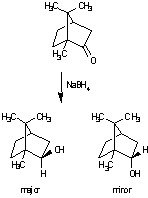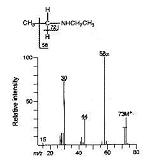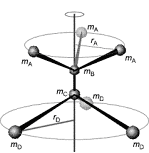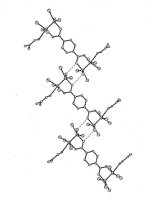Chemistry & Biochemistry
Different types of Chemistry
Fundamentally, chemistry is the study of matter and change. The way that chemists study matter and change and the types of systems that are studied varies dramatically. Traditionally, chemistry has been broken into five main subdisciplines: Organic, Analytical, Physical, Inorganic, and Biochemistry. Over the last several years, additional concentrations have begun to emerge, including Nuclear chemistry, Polymer chemistry, Biophysical chemistry, Bioinorganic chemistry, Environmental chemistry, etceteras. All of these areas of chemistry are addressed in our classes here at UWL to some extent, and by the research interests of our faculty in the Chemistry Department. The following descriptions of the five major subdisciplines were written by several of our faculty members in their field of expertise. All of our faculty members would be happy to elaborate, and/or discuss other aspects of chemistry that are not described below! UW-La Crosse's accredited Chemistry and Biochemistry programs blend technical, hands-on research experience with practical skill development.
 Organic chemistry is a sub-field of chemistry that involves studying the molecules of life. It is mainly concerned with looking at the structure and behavior of these molecules, which are composed of only a few different types of atoms: carbon, hydrogen, oxygen, nitrogen, and a few miscellaneous others. These are the atoms used to construct the molecules that all plants and animals require for their survival. Traditional organic chemists are concerned with synthesizing new molecules and with developing new reactions that might make these syntheses more efficient. The kinds of molecules organic chemists synthesize include useful things like drugs, flavorings, preservatives, fragrances, plastics (polymers), and agricultural chemicals (fertilizers and pesticides), and sometimes include unusual molecules found in nature or ones that might simply provide a challenge to make. Also, understanding something about organic chemistry is essential for learning about biochemistry and molecular biology because bio-molecules such as proteins, sugars, fats, and nucleic acids (DNA and RNA) are all organic molecules, albeit very large ones. Students who concentrate in organic chemistry typically go on to work in pharmaceutical, food or polymer companies, do research or teach in organic chemistry, pursue medical careers, or may pursue other related job opportunities.
Organic chemistry is a sub-field of chemistry that involves studying the molecules of life. It is mainly concerned with looking at the structure and behavior of these molecules, which are composed of only a few different types of atoms: carbon, hydrogen, oxygen, nitrogen, and a few miscellaneous others. These are the atoms used to construct the molecules that all plants and animals require for their survival. Traditional organic chemists are concerned with synthesizing new molecules and with developing new reactions that might make these syntheses more efficient. The kinds of molecules organic chemists synthesize include useful things like drugs, flavorings, preservatives, fragrances, plastics (polymers), and agricultural chemicals (fertilizers and pesticides), and sometimes include unusual molecules found in nature or ones that might simply provide a challenge to make. Also, understanding something about organic chemistry is essential for learning about biochemistry and molecular biology because bio-molecules such as proteins, sugars, fats, and nucleic acids (DNA and RNA) are all organic molecules, albeit very large ones. Students who concentrate in organic chemistry typically go on to work in pharmaceutical, food or polymer companies, do research or teach in organic chemistry, pursue medical careers, or may pursue other related job opportunities.
 Analytical chemistry is the science of identification and quantification of materials in a mixture. Analytical chemists may invent procedures for analysis, or they may use or modify existing ones. They also supervise, perform, and interpret the analysis. Students concentrating in analytical chemistry often go on to work in forensics laboratories, environmental or pharmaceutical companies, work in, manage and/or design quality assurance procedures, pursue research, or teach in colleges and universities.
Analytical chemistry is the science of identification and quantification of materials in a mixture. Analytical chemists may invent procedures for analysis, or they may use or modify existing ones. They also supervise, perform, and interpret the analysis. Students concentrating in analytical chemistry often go on to work in forensics laboratories, environmental or pharmaceutical companies, work in, manage and/or design quality assurance procedures, pursue research, or teach in colleges and universities.
 Physical chemistry is the study of the fundamental physical principles that govern the way that atoms, molecules, and other chemical systems behave. Physical chemists study a wide array of topics such as the rates of reactions (kinetics), the way that light and matter interact (spectroscopy), how electrons are arranged in atoms and molecules (quantum mechanics), and the stabilities and reactivities of different compounds and processes (thermodynamics). In all of these cases, physical chemists try to understand what is happening on an atomic level, and why. Students who concentrate in physical chemistry may go onto pursue careers in industry, research or teaching. A lot of the current physical chemistry research in industry and academia combines the techniques and ideas from several fields. For example, some chemists apply physical chemistry techniques to investigations of the mechanisms of organic reactions (what collisions and bond rearrangements occur, how fast are they, how many steps are there, etc.) - this type of study is called physical organic chemistry. Others apply physical techniques to the study of biological systems (why do proteins fold into the shapes that they have, how is structure related to function, what makes a nerve work, etc.) - this type of study is biophysical chemistry. Still others may use physical techniques to characterize polymers or study environmental systems.
Physical chemistry is the study of the fundamental physical principles that govern the way that atoms, molecules, and other chemical systems behave. Physical chemists study a wide array of topics such as the rates of reactions (kinetics), the way that light and matter interact (spectroscopy), how electrons are arranged in atoms and molecules (quantum mechanics), and the stabilities and reactivities of different compounds and processes (thermodynamics). In all of these cases, physical chemists try to understand what is happening on an atomic level, and why. Students who concentrate in physical chemistry may go onto pursue careers in industry, research or teaching. A lot of the current physical chemistry research in industry and academia combines the techniques and ideas from several fields. For example, some chemists apply physical chemistry techniques to investigations of the mechanisms of organic reactions (what collisions and bond rearrangements occur, how fast are they, how many steps are there, etc.) - this type of study is called physical organic chemistry. Others apply physical techniques to the study of biological systems (why do proteins fold into the shapes that they have, how is structure related to function, what makes a nerve work, etc.) - this type of study is biophysical chemistry. Still others may use physical techniques to characterize polymers or study environmental systems.
 Inorganic chemistry is commonly thought of as those areas within chemistry that do not deal with carbon. However, carbon is very important in many inorganic compounds, and there is a whole area of study known as organometallic chemistry that is truly a hybrid of the traditional disciplines of organic and inorganic chemistry. Some areas of inorganic chemistry that are especially important are catalysis, materials chemistry, and bioinorganic chemistry. Catalysts are chemical entities that increase the rate of a reaction without being consumed, and are typically based upon transition metals (usually) organometallic complexes of transition metals).This is an extremely important area to industry, and many of the chemists who would be identified as inorganic or organometallic chemists work in this area. Materials Chemistry is an area concerned with the design and synthesis of materials that allow the advance of technologies in nearly every area of society. Often, inorganic chemists working in this area are concerned with the synthesis and characterization of solid state compounds or inorganic polymers such as silicones. Bioinorganic chemists study the function of metal-containing compounds within living organisms. Students who concentrate in inorganic chemistry often go on to work in industry in polymer or materials science, do research or teach in inorganic chemistry, or pursue other related job opportunities.
Inorganic chemistry is commonly thought of as those areas within chemistry that do not deal with carbon. However, carbon is very important in many inorganic compounds, and there is a whole area of study known as organometallic chemistry that is truly a hybrid of the traditional disciplines of organic and inorganic chemistry. Some areas of inorganic chemistry that are especially important are catalysis, materials chemistry, and bioinorganic chemistry. Catalysts are chemical entities that increase the rate of a reaction without being consumed, and are typically based upon transition metals (usually) organometallic complexes of transition metals).This is an extremely important area to industry, and many of the chemists who would be identified as inorganic or organometallic chemists work in this area. Materials Chemistry is an area concerned with the design and synthesis of materials that allow the advance of technologies in nearly every area of society. Often, inorganic chemists working in this area are concerned with the synthesis and characterization of solid state compounds or inorganic polymers such as silicones. Bioinorganic chemists study the function of metal-containing compounds within living organisms. Students who concentrate in inorganic chemistry often go on to work in industry in polymer or materials science, do research or teach in inorganic chemistry, or pursue other related job opportunities.
 Biochemistry is the study of the chemical principles underlying basic biological systems. Fundamentally, biochemical research aims to characterize the link between the structure and function of biological macromolecules. More specifically, biochemical research has provided a more comprehensive understanding in regenerative medicine, infectious disease, organ/tissue transplantation, clinical diagnostics and genetic disease. Students who concentrate in biochemistry go on to pursue extremely successful careers in medicine, research, and business. Some students may go on to professional schools directly after completing their undergraduate degrees, while others may enter academic or governmental research settings. Some students also combine their expertise in biochemistry within a Master's of Business Administration (MBA).The combined study in biochemistry and business provides these students with the unique ability to better weigh the cost to profit margin during biochemical product generation. For information on the Biochemistry major, click here.
Biochemistry is the study of the chemical principles underlying basic biological systems. Fundamentally, biochemical research aims to characterize the link between the structure and function of biological macromolecules. More specifically, biochemical research has provided a more comprehensive understanding in regenerative medicine, infectious disease, organ/tissue transplantation, clinical diagnostics and genetic disease. Students who concentrate in biochemistry go on to pursue extremely successful careers in medicine, research, and business. Some students may go on to professional schools directly after completing their undergraduate degrees, while others may enter academic or governmental research settings. Some students also combine their expertise in biochemistry within a Master's of Business Administration (MBA).The combined study in biochemistry and business provides these students with the unique ability to better weigh the cost to profit margin during biochemical product generation. For information on the Biochemistry major, click here.
Graphics Legend:
Organic chemistry: Reduction of camphor by sodium borohydride.
Analytical chemistry: Mass spectrum of diethylamine.
Physical chemistry: Illustration of the moment of inertia of a molecule such as ethane.
Inorganic chemistry: X-ray crystal structure of a novel solid state inorganic compound synthesized by Dr. Rob McGaff's research group.
Biochemistry: Schematic drawing showing the structural elements of lactate dehydrogenase domain I.


